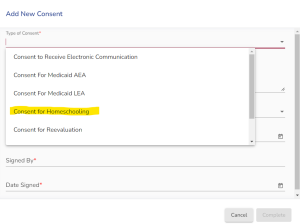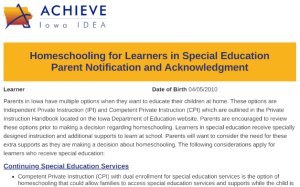Brief descriptions of procedural clarifications, additions, changes and new resources are described below, along with links to related pages within the i3 system.
Part B: Special Education Updates
Open Enrollment Process: Students with Disabilities
The Open Enrollment Page has been updated to reflect current requirements from 281-17.11 and Iowa Department of Education policy in several areas:
- Resolving Disagreements: If the appropriateness of the special education program in the receiving district is at issue, the final determination of the appropriateness of a special education instructional program shall be the responsibility of the child’s IEP team. Previously, AEA Directors of Special Education assisted with disagreements and were responsible for a final determination, if there was disagreement – this is no longer the case.
- Resident District Responsibility for Provision of FAPE: Procedures now clarify that the ultimate responsibility for ensuring that an appropriate program is maintained for an open enrolled special education student shall rest with the resident district. The receiving district and the receiving Area Education Agency director shall provide, at least on an annual basis, evaluation reports and information to the resident district on each special education open enrolled student. The receiving district shall provide notice to the resident district of all scheduled IEP meetings for each open enrollment student.
- Changes of Placement after Open Enrollment: Procedures now clarify that if after accepting an open enrollment request, the receiving district determines it cannot meet the student’s needs, the IEP team must meet and determine a new placement. The receiving district may not terminate the student’s open enrollment nor decide to unilaterally place the student in another district. However, the IEP team could determine that FAPE cannot be provided in the receiving district and a placement could be made in another district program.
- The revised guidance is reflected in the Open Enrollment Page.
- Edits and corrections also made in support documents:
Individual Health Plan (IHP), Emergency Action Plan, Emergency Evacuation Plan
- Procedures have not changed regarding the use of Individual Health Plans. However, in the Health Services: Special Factor Considerations Page, it has been clarified that some learners with life-threatening conditions or impairments may require an Emergency Action Plan. Also, some learners with ongoing health needs may require an Emergency Evacuation Plan to safely evacuate in case of crisis or disaster. These plans, when needed, may be written in the intervention portion of the Individual Health Plan (IHP) or in separate documents referenced in the IHP.
- The Iowa Department of Education has developed templates for the Emergency Action Plan and Emergency Evacuation Plan, which may be used as needed. These plan templates are linked in the i3 narrative and also available in the Special Education Resources Page.
- These templates are integrated into the IHP portions of the Health Services: Special Factor Considerations. They are also linked on the resources page.
Special Factors in PLAAFP: Combined Vision and Hearing Loss
- In the Components of an IEP page, the Hearing and Vision special factors pages were clarified to add guidance for teams to consider the specialized needs of students with combined vision and hearing loss (deafblind students).
Resolving Differences of Opinion, Disagreements, and Disputes
- The Special Education Dispute resolution page was redesigned to concisely describe Iowa’s processes of resolving differences, with links to and alignment with Iowa Department of Education resources and the Procedural Safeguards Manual.
- The revised guidance is reflected in the Resolving Differences of Opinion, Disagreements, and Disputes page.
Part C: Early Intervention/Early ACCESS Updates
Transition from Early ACCESS
- The transition process for learners exiting Early Intervention services and potentially eligible for Part B special education procedures has been revised for clarity and reformatted into a new page for easy access by i3 users. This has been redeveloped into a “page of its own,” under the IFSP primary page, with more detailed guidance on the necessary procedural steps implemented during a learner’s transition from Early ACCESS.
- The revised guidance is reflected in the (new) Transition from Early ACCESS page.
Timely Provision of Early Intervention Services
- Guidance on the timely provision of Early Intervention Services was revised for clarity, noting the importance of providing all early intervention service(s) in the IFSP within 30 calendar days after a parent signs the consent for services. The timely receipt of services is federally reported as a requirement under IDEA. The procedures also summarize the need to document service provision (including timelines) in the service logs of the IFSP in the ACHIEVE system.
- The revised guidance on timely provision of Early Intervention Services is reflected within the Contents of an IFSP section.
Early Intervention Dispute Resolution
- The Early ACCESS Dispute Resolution page was redesigned to concisely describe Iowa’s processes of resolving differences, with links to and alignment with Iowa Department of Education resources and the Procedural Safeguards Manual.
- The revised guidance is reflected in the Early Intervention Dispute Resolution page.
Resources (Part B)
Open Enrollment Flowchart
- This flowchart illustrates the decision making process when families of students with disabilities apply for open enrollment to another district. The flowchart has been edited/corrected to note the correct process when there is disagreement on whether the FAPE can be provided in the potential receiving district (IEP team convenes and decides on appropriate placement). The past practice of Direct of Special Education intervention with disagreements is no longer in place.
- The Open Enrollment Flowchart is included in i3 Special Education Resources, and linked into the narrative guidance on the open enrollment process for students with disabilities.
Open Enrollment Process for Students in Virtual Schools
- This document is a revised/corrected version of Iowa Department of Education Guidance that was put in place when virtual schools were first established in Iowa. The primary correction is alignment with current Iowa code, that indicates when there is disagreement on whether the FAPE can be provided in the potential receiving district, the IEP team convenes and decides on appropriate placement. The past practice of Direct of Special Education intervention with disagreements is no longer in place.
- The revised guidance is reflected in the Open Enrollment Process for Students in Virtual Schools guidance document. This is included in the Special Education Resources and linked into narrative guidance on the open enrollment process for students with disabilities.
Release of Information: Disclosures that Require Consent
- This resource document was reformatted and edited to share correct, current guidance regarding sharing records and communication with foster parents, outside medical or mental health providers, Social Security Administration, Department of Health and Human Services (DHHS) and Iowa Vocational Rehabilitation Services (IVRS). Additional scenarios and examples are given to illustrate cases where disclosures require or do not require consent from a parent or eligible student.
- The revised Release of Information: Disclosures that Require Consent guidance document is available on the Special Education Resource Page.
Resources (Part C)
Codes and Definitions Used in the ACHIEVE System – Early Intervention
- This resource was previously released in January and describes Referral End Codes (when a child does not develop an initial IFSP), Delay Codes (used to monitor the timely service delivery, timeliness of the IFSP services and transition timelines) and Exit Codes (exit reasons for children receiving Early ACCESS services and exit before their third birthday).
- The resource was revised to distinguish between Exit Codes:
- Exit Codes used more than 90 days prior to a learner’s third birthday
- Exit Codes used less than 90 days prior to a learner’s third birthday.
- The revised resource is posted on the Early Intervention Resources page, and linked in relevant i3 narrative sections.
Early ACCESS Annual Eligibility Flowchart
- The process flowchart was reworked and reformatted to provide more clarity regarding the reasons for eligibility (25% delay, diagnosed condition, informed clinical opinion) and summarizing the annual eligibility determination process. Note: “Reevaluation” was renamed Annual Eligibility Determination on the referenced page and in menu references.
- The revised resource is posted on the Early Intervention Resources page, and in linkages on pages/narratives.
Process Changes Related to ACHIEVE
Home Schooling for Learners in Special Education Parent Notification and Acknowledgement Form
- The process for using this form is unchanged in procedures. However, the template form previously used has been removed from i3 resources. This acknowledgement form is used when students with disabilities begin homeschooling – the form documents family choice to either 1) Dual Enroll for special education services, with continued IEP or 2) Decline continued special education, and revoke their consent for their child to receive special education services. The form can now be added to a learner’s record under the Family Consent accordion menu in the Documentation section in ACHIEVE, as illustrated below – choose “Consent for Homeschooling” –

Form will be generated by ACHIEVE:

Iowa Code Changes
IAC Chapter 41: Special Education
- Executive Order 10 required all state agencies to identify administrative rule chapters that would be retained or rescinded (red-tape review).
- The Iowa Legislature site for Chapter 41 hosts the most recent code revisions, dated April 17, 2024.
- Most changes were non-substantive. However, the links to key code references at the bottom of many i3 pages will be corrected in the near future so that users will be directed to the most recent version.
IAC Chapter 120: Early ACCESS Integrated System of Early Intervention Services
- Executive Order 10 required all state agencies to identify administrative rule chapters that would be retained or rescinded (red-tape review).
- The Iowa Legislature site for Chapter 120 hosts the most recent code revisions, dated May 29, 2024.
- Most changes were non-substantive. However, the links to key code references at the bottom of many i3 pages will be corrected in the near future so that users will be directed to the most recent version.
Organizational/Web Design Changes
In June, several sections/pages of Early Intervention/Early ACCESS content will be redesigned and reorganized under parent pages and drop-down menus. This will not involve any substantive content changes, but users may find key information more easily located.
